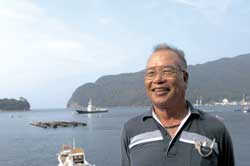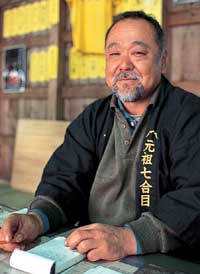| Web Japan > NIPPONIA No.35 > Special Feature* |
|
|
|
NIPPONIA No.35 December 15, 2005 |

An umbrella-like condensation cloud hovers just above the summit. This type of cloud is sometimes seen in winter when the air is very cold. It signals a continuation of clear skies.
(Photo: JTB Photo)
|
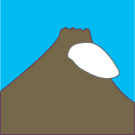 |  | 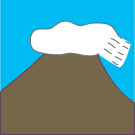 | 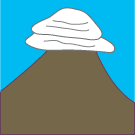 | |||
|
A cloud hanging like an apron over the 8th station. Often seen
on clear days in spring and fall. |
In the spring and summer, when Fuji wears a hat like this one, there is a good chance the weather
will turn to rain. | A wavy formation on the clouds over the summit means strong winds will soon blow.
|
When layers of clouds form over the summit in summer, you can expect heavy rain and strong winds.
(The four illustrations and the photo above them show the south flank of the mountain.) |
|
Clouds over Mount Fuji predict the weather
Inaki Noboru, fisherman working out of Heda Fishing Port
Mount Fuji towers before Inaki Noboru as he takes his fishing boat through the inlet into Suruga Bay. He has just left the small fishing port of Heda in Numazu, Shizuoka Prefecture.
“I'm so used to it I hardly even notice any more—except at the first light of dawn, when the fishing's done and I'm heading home. Then it looms up, a pitch-black, beautiful shape floating in the air. It can still startle me then.”
Inaki turns 70 this year. When he was just a boy his grandfather would take him out fishing. “In those days, we used a rowboat.”
While fishing, his grandfather kept an eye on the clouds over the mountain. “Often he'd stop work suddenly and turn the boat toward port, saying the wind was going to blow hard and make high waves. I'd look up and see that the top of the cloud above Mount Fuji had an up-and-down wavy shape. In time, without consciously trying to do so, I knew how to forecast the weather from the shape of the clouds on the mountain.”
Of course, these days he is sure to listen to the weather forecast before heading out to fish. “But the weatherman is often wrong. Sometimes you can get a more accurate forecast by looking at Fuji's clouds,” he grins.
|
|
Living and working high on the slope
Yamaguchi Yoshimasa, owner of Ganso Nana-gome Yamaguchi Mountain Hostel
“In July and August I'm almost always here,” says Yamaguchi. The mountain hostel he owns, called Ganso Nana-gome Yamaguchi, is a 150-minute climb from where the road for vehicles ends at Shin Go-gome, and almost exactly halfway from there to the summit on the Fujinomiya-guchi Trail.
On weekends during the two-month climbing season the hostel is just about filled to the rafters. It can accommodate about 160 trekkers at a time. Around eight people work at the hostel, including part-timers, and there is almost no time for them to sleep during the night.
His father ran the hostel years ago, so he has known the mountain for as long as he can remember. He used to help out as a senior high school student, and even after he got a company job he would go on weekends to lend a hand. When his father became sick he quit his job, and took over from his father eight years ago, becoming the eighth owner of the hostel.
“We are open only two months a year, but it's surprising—and interesting—how many kinds of people we meet here. When the climbing season is over we have no steady income, but you can't beat making a living at the No.1 location in Japan,” he smiles with pride.
|
|
||||||
|
